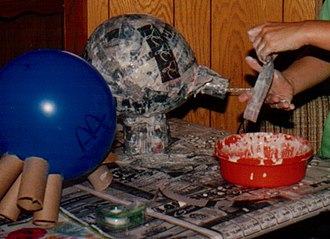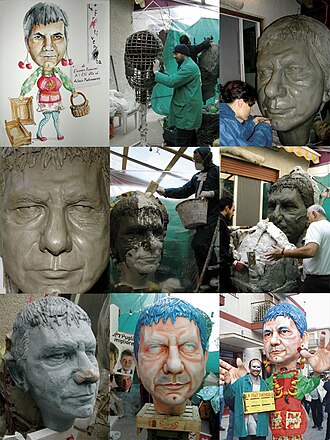Difference between revisions of "AY Honors/Paper Maché/Answer Key"
m (17 revisions: import with history from WB) |
|||
| Line 1: | Line 1: | ||
| − | {{honor_header|Unknown|Unknown|Arts and Crafts|East Africa Division}} | + | {{honor_header|Unknown|Unknown|Arts and Crafts|East Africa Division|Paper_Mache_Honor.png}} |
==1. Name at least three kinds of bases upon which paper models may be shaped.== | ==1. Name at least three kinds of bases upon which paper models may be shaped.== | ||
Revision as of 22:24, 23 July 2012
1. Name at least three kinds of bases upon which paper models may be shaped.
When wet, paper maché has very little form and will not hold its shape. So the first step in making a paper maché project is to make a base onto which the paper maché is applied. Bases can be made from many different items, including:
- Balloons: Inflate a balloon and tape other items onto it, such as paper cups, toilet paper rolls, or other items.
- Plastic bottles: Attach golf tees for legs to turn a plastic bottle into an animal (such as a pig).
- Aluminum Foil: Press the foil around a person's face to get an image of it. If the subject wears glasses, leave them on. Carefully remove the foil and place crumpled newspaper into it to help hold the shape.
- Paper Plates: These make an excellent base for constructing a mask.
- Cardboard Boxes: Use small cardboard boxes such as those in which many food items are packaged.
- Wire and Wire Mesh: Form wire into the desired shape. Especially useful for this is fencing wire (such as chicken wire) and gutter guard mesh. Hardware cloth is a little too stiff to work with.
2. There are two main types of paper maché:
a. Know how to prepare successful pulp
Pulp is paper which has been shredded into tiny pieces. First tear the paper (newsprint works well) into small pieces. In some instances, this will be good enough, but if you need finer pulp, throw the paper into a blender with some water. You can also get good raw material from an office paper shredder. When the pulp is as fine as you desire, add white glue and wallpaper paste. Amounts are not given here - you need to experiment to find a consistency that works well for what you are tring to do. Once it's mixed with glue, the pulp can be shaped like clay, or you can layer it onto a base.
b. Know how to prepare the glue
- 6 cups water
- 1 cup flour
Mix the flour into the water thoroughly with your hands, being sure to break up all the lumps. You might try heating the mixture too, but do not let it come to a boil. You can vary the amount of flour or water to make the glue thicker or thinner. Experiment to find what works best for you.
You can also add a few tablespoons of bleach to retard the growth of mold, but make sure everyone who is going to use the paste knows that you did this - after all, flour and water are the same ingredients that you use to make bread, and you don't want your Pathfinders performing any taste-tests on a bleach-laden batch of glue!
Glue is used with strips of paper which are layered onto the base. When the glue dries, the paper stays in place and binds together forming a (hopefully) beautiful sculpture.
3. Be familiar with all ingredients and know why they are used.
- Here are some thoughts on the paste from Wikipedia: Paper Maché
- Paper-mâché paste is the substance that holds the paper together. The traditional method of making paper-mâché paste is to add one part water to one part flour. Some artists prefer to boil the paste, saying that it makes the consistency smoother. Water to flour ratio is changed to five parts water to one part flour in this case. Other artists use a three to one or a one to one ratio of water and Polyvinyl acetate (PVA glue). Still others say that starch makes a fine paste. Adding a dash of cinnamon to the mixture gives the paste a pleasant smell; adding a dash of salt reduces the chances of the product developing mold.
4. Make, paint and varnish at least two articles from pulp.
5. Make, paint and varnish at least two articles from paste and paper strips.
6. Submit articles to examiner and have workmanship approved.
As the instructor, you will be responsible for judging the workmanship of the projects. The most important consideration is that you apply a fair standard and not show favoritism. Pathfinders are quickly able to detect unfairness, as it is an extremely important concept to them.


